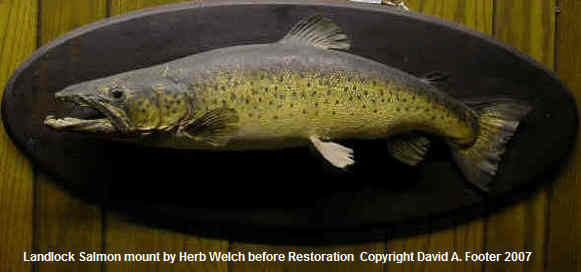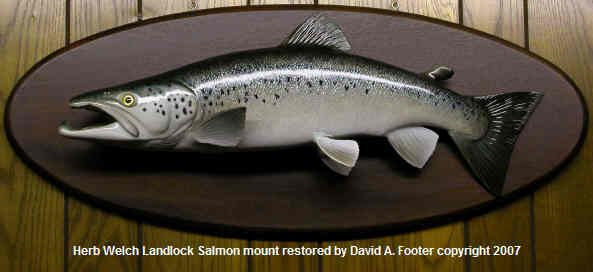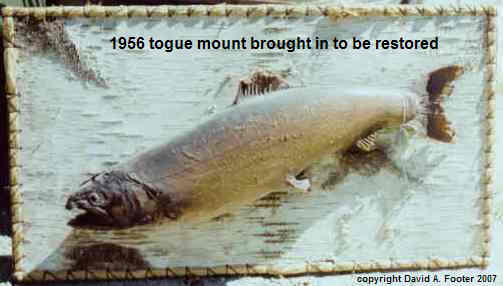Restorations: Giving old mounts that lifelike luster.


When fish are freshly caught, they are a wonder to behold. In many cases their bodies are covered with dazzling living color. It is the work of taxidermists to capture that beauty, thus giving fishing folks, young and old the opportunity to relive and share that exciting memory.
Top Photo: A Landlock Salmon mounted by renoun taxidermist Herb Welch of Oquossoc, Maine that was brought in to another Maine taxidermist to be restored, David A. Footer- Artistic Fish Mounting and Wilderness and Wildlife Artist.
Second Photo: Same Herb Welch Landlock Salmon mount now restored by Master taxidermist, David A. Footer and his assistant and daughter, Julie A. Footer
What to do when you happen to find a trophy catch but you weren’t fishing in usual kinds of places.
What if the biggest fish you ever land doesn’t come up out of the water into a boat your in or out of a stream you’ve been fishing but was stored in someone’s attic or shed, summer or fishing camp? What if it were covered with smoke and grease, was damaged by water or varmints have eaten off part of it for their lunch? Some of our readers may be saying “Gross!” or “yuck!” right about now. But if you have found such a fish and have shown it around, it’s possible you’ve heard these comments yourself. Have you wondered whether or not you should keep it? Do you want to know if there is anything that can be done to help its appearance or to protect it from further breakdown? Is it of any value? If so, how much, you might ask? Well, if you wish to keep it, we hope this page and others linked to it will help answer those type questions. Not all older mounts are in bad shape as you will see they come to us in varing degrees of disrepair.
Auctions are also a great place, for just this sort of fishing! A couple of years ago, one of David’s fish customers called and asked if David would be willing to go check out a fish mount. A brook trout that was mounted under glass and was up for auction in a nearby town. David agreed to go and have a look. After he inspected it, he verified that it was a Herb Welch mount in excellant condition. The piece which must have had some very interested and loyal buyers, was sold from what we heard for over twenty thousand dollars.
Not everyone is as fortunate as that though when they come across an antique fish mount. Mounts are found and often times they are not a pretty sight. However, they may be part of a very rich family history, state history and at the very least they are a connection to a story that someone treasured so much that they made an effort to capture it, preserve it and to share it with others.
In his artful way, David brings back to each piece something that was lost.
In their day taxidermists, Hinds, Parke, Nash and Welch had thriving shops here in the State of Maine, and it is safe to say that each did hundreds of mounts during their lifetime. Many people sought them out because of their reputation for quality work.
Here are some examples of the work David A. Footer has done over the years to help bring mounts back to their lifelike appearance and keep their stories alive for years to come.
The before and after photos directly below are of a brook trout mount on an oval birch bark panel. As the Sun Journal article reported, “that many an adult fisherman looked on enviously at Pettingill Park today as a ten year old boy of Auburn, pulled out a 14 1/2 inch brook trout to win the biggest fish award of the Auburn Exchange Club County Fair fishing derby”. Having the fish mounted by David A. Footer was the award for catching the biggest fish.
David had already been in contact with Herb Welch nearly four years by the time he mounted this particular trout and Herb was guiding him in his work. David bought one of Herb’s mounts on a birch bark panel to study how it was made. As a young man, with meager resources to support wife and growing family, David found creatived ways to promote his work. He found that offering to wave the mounting fee on mounts that could bring him free publicity such as this community sport’s event, or tackle shop’s and some fishing camps, he saved on advertising costs and word about his talent began to spread.
Both mounts below were mounted in the same year, 1956. In 2003, the very fish mount was brought back to David to touch up. There are two or three points to comment on as part of David’s progress in the field of Taxidermy. The birch bark panel has only one loop per lacing hole which if you take a look at the birch bark panel on the second mount below has changed and David has stayed with the change until present day. The second is the amount of curve in the shape for the fish. David learned that by modifying it slightly, he caught a more lifelike action in the carving on the body.
This is one of David’s mounts done in 1956, the year before his daughter and now assistant was born. The panel was restored and if you look closely you can detect the mark or the scar on the birch bark that looks like an upside down W. The panel was cut down to a better size to give the mount a more balanced look.

We hope you enjoy seeing these and hearing about them.
All photos are owned by David A. Footer or are have been used with permission and though we hope you enjoy viewing them, any reuse without permission is strickly prohibited.
